|
Kitbashing
a 1/48 scale Canadair
CT-133 Silver Star
by David Askett
|
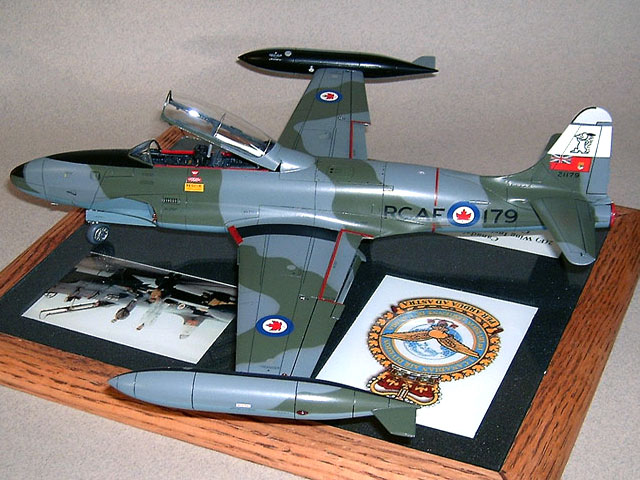 |
|
Canadair CT-133 Silver
Star |

HyperScale is proudly supported by Squadron.com
But Why?
This is usually the first question I’m asked by
modellers; why go to all the trouble of kitbashing this model when two
different 1/48 scale kits of the T-bird, from Hobbycraft Canada and
Testors/Hawk, are readily available? Well, both these kits look
undeniably like T-birds when built up, but both have pretty major
accuracy problems that are glaringly obvious to anyone who’s familiar
with this aircraft. Of the two, the older Testors/Hawk kit is,
surprisingly, more accurate in shape than the much later Hobbycraft
offering. I considered basing my model on this kit, correcting faults
where necessary and adding extra detail, but in the end I decided it
would actually be easier to make my Silver Star the way Lockheed did –
start with a P-80C Shooting Star, and turn it into a two-seater!
I came to this decision after picking up a
second-hand Monogram P-80C Shooting Star at a club swap meet for the
princely sum of $3. This old kit captures the shape of the P-80 very
well, and does not have any serious accuracy problems. By combining
Monogram’s kit with the best bits from the T-bird kits by Hobbycraft and
Testors/Hawk, I realized that a very nice model could result.
The Real
Aircraft
The Lockheed P-80 Shooting Star, designed in 1943
and first flown on January 8, 1944, was not a terribly successful
fighter by anyone’s standard. It did, however, achieve a number of
“firsts” during its time in service; first USAF aircraft type to exceed
500 mph in level flight, first jet to be manufactured in large
quantities, first U.S. jet type to be used in combat, etc. Probably its
greatest claim to fame, however, came when a second seat was added to a
P-80C to convert it into a trainer, and one of the greatest aircraft of
all time - the TP-80C, later renamed T-33A - was born.
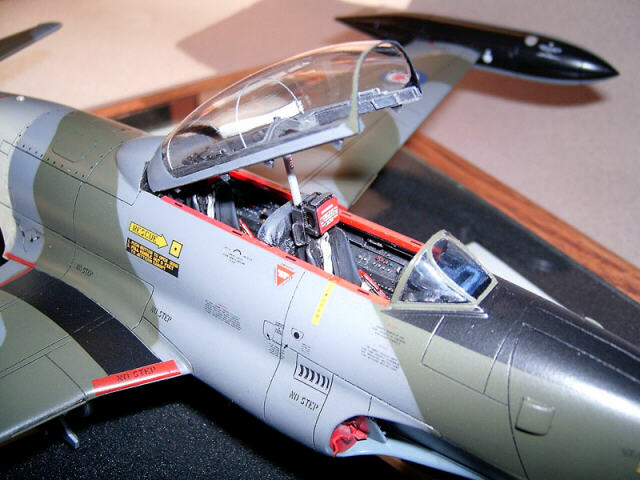
The TP-80 trainer was developed from the P-80 in
1947, in response to an earlier suggestion from the USAF and an
increasing number of P-80 accidents. To make room for an instructor aft
of the pilot, Lockheed modified a standard P-80C fighter by reducing the
size of the fuselage fuel tank, inserting a 26.6” long plug in the
fuselage forward of the wing leading edge and, to balance things, a 12”
long plug in the fuselage aft of the wing trailing edge. To make up for
the reduction in fuel capacity that resulted from shrinking the fuselage
fuel tank, wing tip tanks were added. To conserve weight, the built-in
armament of six 0.50” machineguns was reduced to two.
The new trainer first flew on March 22, 1948. It
was an immediate success, with handling characteristics equal to those
of the P-80C and a HIGHER top speed due to its longer, more aerodynamic
fuselage. Initially designated TP-80C, the aircraft was rechristened
TF-80C on June 11, 1948, and finally T-33A on May 5, 1949. Production of
the type continued until August, 1959, by which time Lockheed had built
5691 T-birds at a cost of $123,000 apiece. By comparison, only 1731
P-80s were constructed, each costing $93,456.
American-built T-33s served in the air forces of
more than twenty countries. Additional T-birds were built under license
in Japan and Canada.
Canada and the T-bird
In support of the NATO buildup during the Cold War,
Canada undertook to provide training to not only its own aircrews, but
also for several thousand Allied personnel. To provide for the jet
training phase of the program, Canada was initially given twenty
T-33A-1LO T-birds by the U.S. government, and loaned an additional ten
by the USAF. These T-birds were later returned to the USAF, or
transferred to other NATO countries after the RCAF standardized on the
Canadian-built version of the T-33.
Canada began building its own T-birds in 1951, the
first flight taking place on November 27, 1951. Powered by a 5100 lb.
thrust Rolls Royce Nene engine, in place of the Allison J-33 fitted to
the American version, the Canadiar-built version was known within the
company as the CL-40 but designated T-33A Silver Star Mk.3 by the RCAF,
later renamed CT-133, but was usually referred to simply as the T-bird.
Eventually, a total of 656 Canadair-built T-birds would be delivered to
the RCAF, serving in various roles such as armaments training,
photoreconnaissance, pilot training, target tug, ejection seat trials
aircraft and hack. The well-liked aircraft would continue in Canadian
service until its retirement in 2004. Canadian-built T-birds were also
operated by the air forces of France, Greece, Portugal, Turkey and
Bolivia.
Construction
/ Conversion
|
A few years ago I built Hobbycraft Canada’s kit of
this aircraft, with minimal improvements. The resulting model looked
nice, but unfortunately never looked quite “right” to my eye. It became
obvious that the model had a number of shape problems, the most
important ones being intakes that are too short, an oddly-bulged mid
fuselage that makes the model look over-inflated, a rear canopy fairing
that’s too short and misshapen, and cockpit sills that not only slope
downwards towards the front, but also converge when they should be
parallel. These faults combine to result in a model that, to me at
least, looks more like a caricature of the T-bird than the real thing.
To build a more accurate T-bird, I’d intended to
combine the best parts from Hobbycraft’s kit with the more accurately
shaped fuselage from the Testors/Hawk kit. Upon further examination,
though, it became apparent that Testors’ kit, though more accurate than
Hobbycraft’s, nevertheless had its share of problems as well. It was at
this point that I acquired the second-hand Monogram P-80, and decided to
make it the basis for my model.
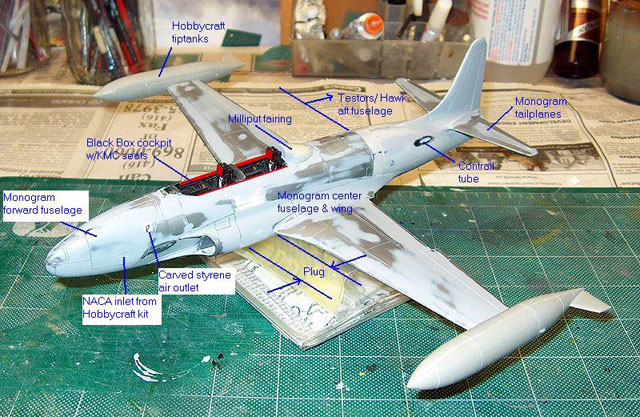
Monogram’s kit of the P-80 Shooting Star dates back
to the mid ‘Seventies and is beginning to show its age, with its limited
detail and raised panel lines. With just a little extra work, however,
it can be built into a very impressive model. More importantly to me,
its shape and dimensions are very nearly perfect, meaning that it could
be relatively easily converted into an accurate model of the T-33.
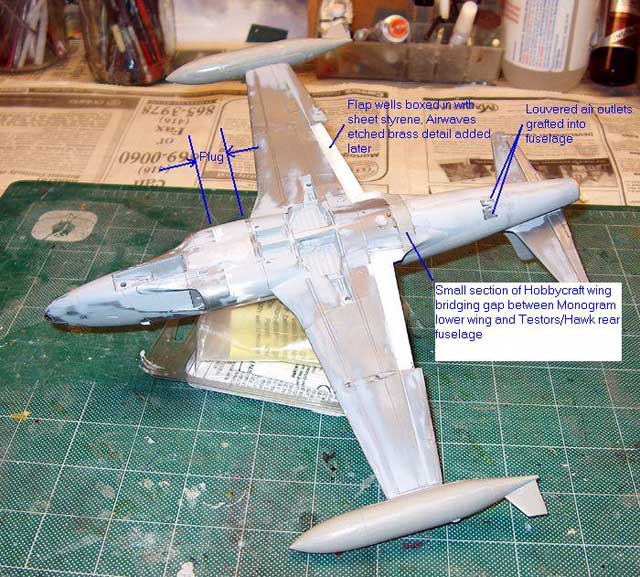
The labeled photos of the unpainted model show the
major work carried out. Suffice it to say, there was a lot of surgery
involved! The major components all fit surprisingly well, though,
despite the fact that they were sourced from three different kits. More
importantly, the resulting model “looks” like a T-bird, and its scale
dimensions match those of the full-sized aircraft very closely.
In addition to the Hobbycraft and Testors/Hawk T-33
kits, and the Monogram P-80, other products used on the model were:
Reheat – etched
brass set for the flap wells
Black Box – resin
cockpit set
KMC – resin
ejection seats; to me these appeared more accurate to me than Black
Box’s seats.
MV Railroad Lenses
– for the landing lights attached to the top of the nosewheel leg.
Falcon –
vacuformed canopy hood. This was modified so that the sides ran parallel
to each other, instead of converging towards the front. The windscreen
wasn’t used as it is much too large; the far more accurate windscreen
from Monogram’s P-80 was used instead. Note that, on every T-33 and
Silver Star I’ve ever seen at least, the windscreen center panel is
tinted blue.
The nosewheel is the one from Monogram’s F-86 Sabre
kit, cut in half and widened approximately twenty thousandths of an inch
with sheet styrene.
After the model was assembled, it was completely
rescribed using an Olfa P-Cutter, calligrapher’s scratch knife, the back
of an Xacto No.11 blade, and a pin chucked into a knife handle, as
appropriate.
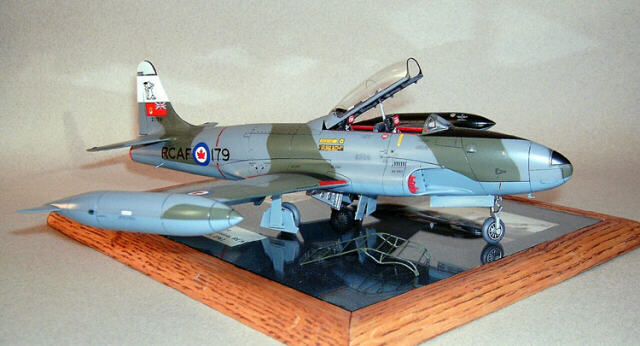
After discovering a fantastic photo of T-bird 21179
as it appeared while serving with 2 Wing Instrument Flight at
Grostenquin, France in October 1962 at www.grostenquin.org, my mind was
made up about as to which particular aircraft the model would be
finished as. Gunze acrylics, custom-mixed to match the Canadian
versions of NATO’s standard camouflage colours Dark Green, Dark Sea
Grey and PRU Blue, were applied with an Iwata HP-BCS airbrush.
Aside from the Snoopy artwork on the tail, which I
drew on my computer and printed on clear decal film, the decals came
from various sheets from Leading Edge Models. The FOD covers and
boarding ladder (I never did work up enough nerve to permanently glue
the ladder to the finished model!) were scratchbuilt from plastic and
metal.
I really enjoyed working on this project, and am
happy with the result, but we REALLY need an accurate, detailed new
model kit of this incredibly important aircraft type.
Are any manufacturers listening?
Click
the thumbnails below to view larger images:
Model, Images and Text Copyright ©
2005 by David Askett
Page Created 27 March, 2005
Last Updated
26 March, 2005
Back to
HyperScale Main Page |
Home
| What's New |
Features |
Gallery |
Reviews |
Reference |
Forum |
Search